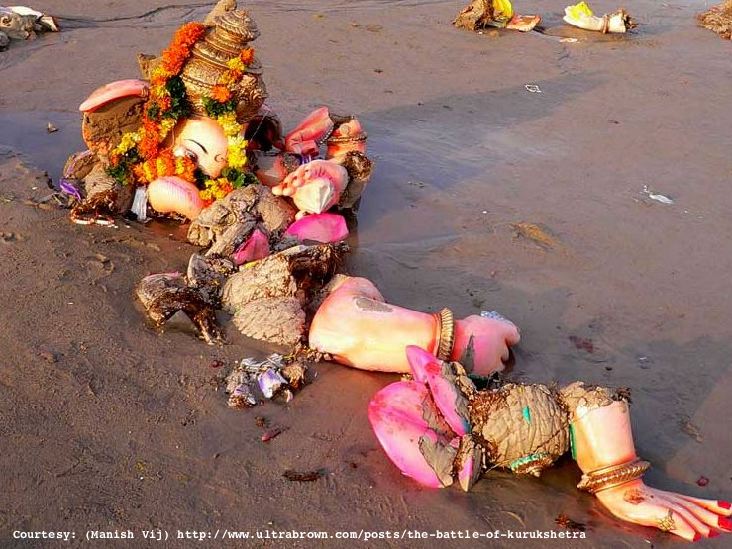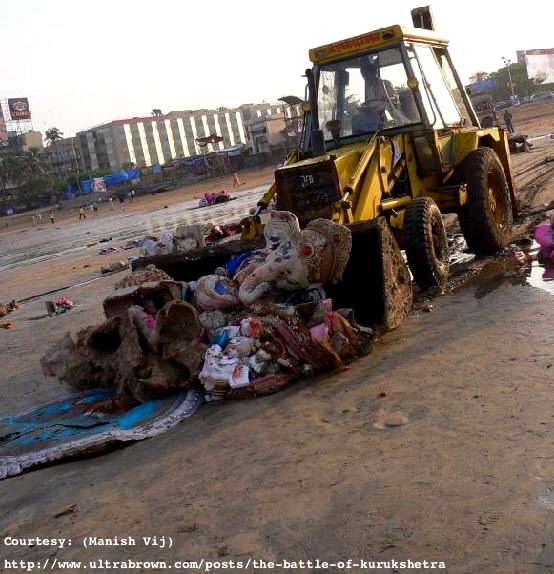In Bombay, a lot of Ganesh idols are made by the humble artisans whose workshops come to life in the days leading up to the festival. The colors range from the orange hues of the majestic Siddhivinayak or the ornate, little Ganeshas all dressed up in pink dhotis and golden crowns. The Ganesh stays in the house like a much-loved guest. The homes that welcome the idol constantly carry the scent of incense and camphor. A corner of the house where Lord Ganesha sits looks all lit up and decorated. There is the rare abundance of modaks, the sweet cardamom flavored dumplings with a coconut filling that melts in your mouth. And then one day amidst melodious aartis and impassioned cries beseeching Ganpati Bappa to come again next year, the idol is immersed into the sea.

When this tradition first began the idols were made of clay which when immersed in water would dissolve, returning the spirit of this deity to the depths of nature. But lately, especially in Bombay, this festival has gained commercial significance. Public celebrations have created a competition where communities are seen vying each year to hoist the biggest idols on their pedestals. Enormous funds are gathered by the locals and the largest, most colorful of sculptures is put up, much like an exhibit. While this practice has helped cultivate a sense of community, the idols themselves are no longer made from environment friendly clay. The murtis (idols) that are placed for the visual delight of the crowds are now made from Plaster Of Paris.
Plaster Of Paris is easier to mould and the several intricate patterns that go onto a Ganesh idol are easier to carve on this material. Moreover, the increasing demand for Ganesh idols and the large sizes that are so popular make the artisans look towards the cheaper option. Plaster Of Paris is much cheaper than clay but unfortunately less soluble in water. As a result the Ganesh idol that has been treated like a beloved houseguest by so many faithful devotees, sits at the bottom of the ocean, slow disintegration of the plaster releasing toxic elements into the water. The chemicals used in painting the idol contain hazardous mercury and cadmium metals. As the magnificent four arms, golden crowns and loving brown eyes of the elephant god crumble into the seawater, the ocean's flora and fauna suffer from the sudden increase in acidity and toxicity of the water. For years this issue has been tap-danced around to protect religious sentiment. But the urgency of protecting the environment should probably hold more importance and urgency than people's religious sensitivities. Surely, educated men and women understand that to abuse the divine gift of nature is in no way a means of paying obeisance to a deity.
Those whose religious sentiments are hurt when it comes to protecting the environment have never taken a walk along the beaches in Bombay a day or two after the immersion (Anant Chaturdashi). A collection of pictures by Manish Vij shows the large disfigured, broken, scraped and dismembered Ganesh idols that float in with the sea debri onto the shore. A municipality truck arrives, gathers this debris like it would gather garbage and disposes it. Along with this debris are dead fish killed by the toxins and the high acidity of the seawater. So much for religious sentiment.

The Ganesh Chaturthi festival is a time when communities unite and celebrate together. Nobody wants to lose out on the festive occasion. But finding a way to be kind to the environment while indulging in the festivities is a responsible thing to do. There are always devotees who want to have an environment friendly Ganesh Chaturthi and wonder what their options are. There are various options to buying a large Plaster Of Paris idol. In fact, Wikipedia outlines a few easy and feasible solutions to addressing this issue:
<
1. Return to the traditional use of natural clay idols and immerse the idol in a bucket of water at home.
2. Use of a permanent idol made of stone and brass, used every year and a symbolic immersion only.
3. Recycling of plaster idols to repaint them and use them again the following year.
4. Ban on the immersion of plaster idols into lakes, rivers and the sea.
5. Creative use of other biodegradable materials such as paper mache to create Ganesh idols.
6. Encouraging people to immerse the idols in tanks of water rather than in natural water bodies.
The Girgaum area is famous for skilled artisans who use traditional and environmental friendly clay to make the idols. There are famous Ganeshotsav mandals that choose to make creative Ganesh replicas from flowers, paper mache, coconuts etc. The Ganeshotsav mandals can choose to give out a prize for the one who comes up with the most environmental friendly design for a Ganesh idol every year. Families can buy a smaller, clay Ganpati for their home. A small idol can be prayed to. Faith should not be incumbent on the size of the idol, should it?
Commercialization of religious festivals likely has a positive influence in nurturing communal sense but when the celebration ends and the environment suffers, people need to evaluate this problem and treat it like their own. After all, Lord Ganesha would not want the beautiful gift of natural resources to be exploited and abused in this manner. Surely our devotion should not be blind towards God's fine creations in our zeal to uphold his idol.
4 comments:
Very well said, Aditi, about the abuse of mother earth/nature during the Ganesha festival and the harm done to marine life due to toxic paints and materials dumped into the sea.
Festivals should be meaningful & uplifting for all species, not just for humans.
The pujas conducted are excellent to purify the atmosphere and unite people in a feeling of sanctity and festivity. But what happens after that is deplorable.
My friend brought up a new idea during Ganesha celebrations - the family idol, which is part of her shrine, was used for the pujas and veneration. Beside it was another statue of Lord Ganesha made in wheat flour! When I questioned her about that statue, she said that it is the one that wil1 go for immersion - so that fish wont suffer, on the contrary, it will serve as food for them!
What a compassionate way to celebrate the festival of the Lord that removes all obstacles. May her tribe increase and may we all see Mother Nature as the most divine form of God and learn to respect her and all life that is part of her.
Lokha Samastha Sukino Bhavantu - May all beings in all the worlds be happy - may all be healthy and may none suffer. Om Shanti, Shanti, Shanti.
i live in jaipur but my mother belongs to bombay........and so i have been visiting it since my birth......i always love this festival but always think about wat happens to these idols once immersed.......
i sometimes don't understand that how can man be so greedy that in the name of god he earns money.......i like sculpting and always do it with clay and i know how eco-friendly this material is....i fully support ur thought and agree to it.......some concrete action have to taken against it....these people who just try to fill there pockets by playing with the mother nature and relegious sentiments of people should be punished hard.....
You are band on target. People mainly in Mumbai need to wake. I myslef being a part of a mandal have spoken to the leads but its thought process and mindset which has kept people away from even give a single thought about effective eco-friendly Ganesh Festival.
Regards,
Chetan
chetan.poojari@gmail.com
You are band on target. People mainly in Mumbai need to understand this and its urgency.
Post a Comment